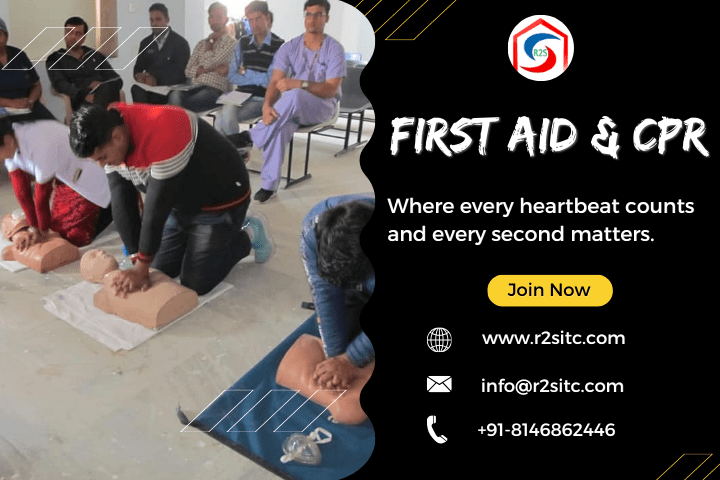Knowing how to provide first aid and CPR quickly and efficiently can be the critical difference between life and death in emergency situations. Knowing the fundamentals of these life-saving skills is not simply a responsibility, but also a skill that can enable people to become heroes in their daily lives. We examine the importance of first aid and CPR training in this extensive book, going over the principles, advantages, and practical uses that may turn anyone into a competent and self-assured lifesaver.
The Value of CPR and First Aid Education
Why Everyone Needs to Know How to Perform First Aid
The first step in learning first aid and CPR is realizing how important these abilities are. Apart from being a prerequisite for specific occupations, first aid is a competency that is applicable to all types of injuries and medical crises, enabling people to react appropriately. Know how to recognize and treat medical emergencies quickly, whether at home, at work, or in public. It can make all the difference between life and death.
The Significance of CPR in Life-threatening Events
A vital component of emergency response, cardiopulmonary resuscitation (CPR) is intended to keep the heart from stopping while maintaining blood flow and oxygenation. Understanding how to conduct CPR can greatly boost a person’s chances of surviving until expert medical help arrives, whether they are experiencing a sudden cardiac arrest or are about to drown. The science of CPR is examined in this part, with a focus on how vital it is to maintaining life in an emergency.
Knowing the Fundamentals of First Aid
Examining the Situation and Providing Safety
Any first responder must learn to evaluate the scene for any threats and make sure they and others are safe before they can focus on the specific procedures. To assess the seriousness of the issue and take necessary action, this entails comprehending the idea of the “ABCs” – monitoring Airway, Breathing, and Circulation.
Handling Typical Injuries: Burns, Cuts, and Fractures
First aid covers ordinary injuries that people may get in regular life in addition to emergency emergencies. This section offers practical advice on managing a range of injuries, stressing the significance of prompt and efficient intervention. It covers everything from treating burns and cuts to giving first care for fractures.
Understanding Medical Emergencies: Allergies, Heart Attacks, and Strokes
Some medical emergencies require prompt response as well as a particular course of action. It’s critical to identify the signs of a heart attack, stroke, or severe allergic reaction in order to get prompt medical attention. This section of the guide provides readers with information on the symptoms and indicators of various emergencies as well as the proper first aid procedures to follow.
Learning CPR Techniques
CPR for Hands-Only: A Comprehensive Guide
For people who might feel uneasy or uninitiated with traditional CPR techniques, hands-only CPR has become a simplified yet incredibly successful technique. This section provides readers with a step-by-step guidance to perform hands-only CPR confidently, breaking down the method into manageable segments.
Conventional CPR Using Rescue Breaths: Essential Information
This section of the guide offers comprehensive instructions for individuals who are prepared to perform the entire range of CPR procedures, including rescue breathing. Readers obtain a thorough comprehension of conventional CPR techniques, from determining responsiveness to doing efficient chest compressions and rescue breaths.
The Advantages of Certified First Aid and CPR
Advantages for both the workplace and the individual
Beyond the inherent significance of being ready to handle emergencies, earning certification in first aid and CPR has numerous advantages for both the workplace and the individual. This section examines the ways in which certification can improve one’s chances for employment, improve the wellbeing of the community, and foster a sense of self-assurance and empowerment.
Applications in the Real World and Success Stories
Case Studies: The Impact of First Aid and CPR Instruction
Situations from everyday life highlight the significance of first aid and CPR instruction. This section of the guide illustrates through a number of case studies situations in which people, equipped with the skills they had learned in training, were able to save lives and stop additional harm.
Applications in the Real World and Success Stories
Success Stories: Typical People, Unusual Deeds
The guide offers motivational accounts of common people who became heroes by quickly and skillfully administering first aid and CPR, whether they were bystanders at a public event or coworkers in an office setting.
Getting Past Training Obstacles
Taking Care of Common Misconceptions
Despite the obvious advantages of first aid and CPR training, obstacles and misconceptions sometimes discourage people from learning these vital skills. Common myths are addressed in this section, as well as concerns and assurances for those who might be hesitant to participate in training.
Providing Accessible Training: Community Workshops and Online Courses
This section of the guide examines the availability of online first aid and CPR courses as well as community workshops, acknowledging the requirement for flexibility and accessibility. It highlights the variety of choices people have while learning these life-saving abilities.
In conclusion, Knowledge Empowers
To sum up, enrolling in first aid and CPR training is more than just learning new skills; it’s a life-changing event that enables people to take an active role in their own safety and the protection of others around them. The capacity to react to emergencies in a professional or personal setting, whether at home, at a community function, or both, is a life skill that cuts across age, profession, and background. The main takeaway from this guide, which covers a wide range of first aid and CPR training, is that anyone can save a life and that information is our most powerful weapon when faced with uncertainty. It’s time to take charge of our workplaces, communities, and ourselves.
R2SITC
In summary, enrolling in first aid and CPR training is a life-changing event that enables people to take an active role in their own safety as well as the protection of others around them. It’s not merely a way to get new skills. The capacity to handle situations well is a life skill that cuts across age, profession, and background, whether it be at work, at a community function, or at home. This tutorial covers a wide range of first aid and CPR training, but the main takeaway is that anyone can save a life and that information is our most powerful weapon when faced with uncertainty. Visit R2SITC and enhance your knowledge.


